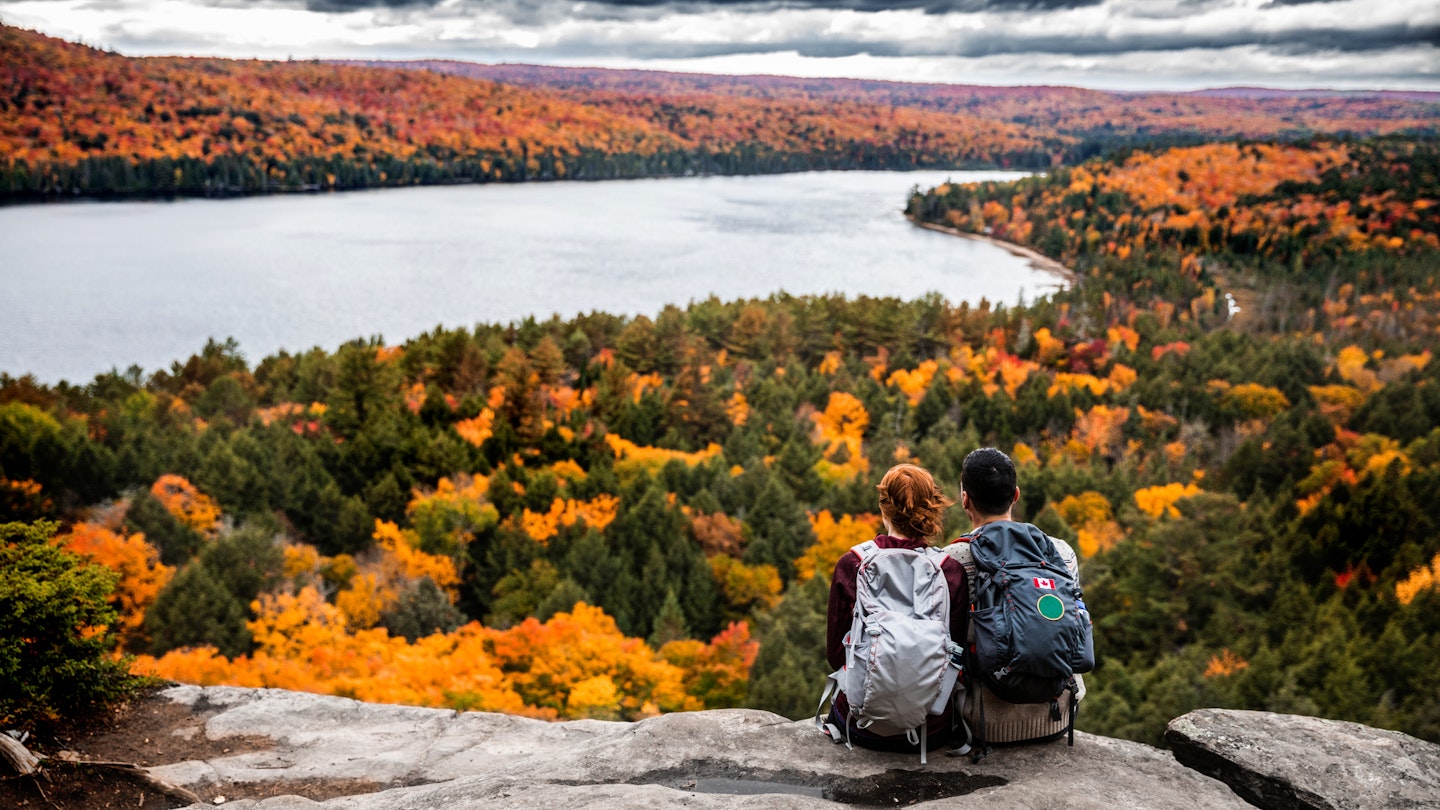Discover Algonquin Provincial Park: A Nature Lover’s Paradise
A life-long fan of destinations that revolve around spending time in the water, writer Isabella Noble recently returned from a restorative trip to Algonquin Provincial Park in Ontario. Here, she shares a snapshot of her time spent swimming, canoeing, hiking, sunset-gazing, wildlife-spotting, and more.
During the hot and humid 2023 summer in Toronto, my Canadian partner and I hopped in a hire car and headed around 300km (186 miles) north across Ontario. Just a few hours later, I was cooling off with a swim in a glassy lake, with bright-green pine-and-maple forests stretching for as far as you could see into the distance beneath a bright-blue, cloud-flecked sky – a classic scene in serene, wildly beautiful Algonquin Provincial Park.
With 7600 sq km (2900 sq miles) of forested wilderness and thousands of tree-rimmed lakes and interconnected waterways, Canada’s oldest provincial park offers a taste of the country’s immense natural beauty within comparatively easy reach of Toronto and Ottawa (both around three hours’ drive away). This area is the traditional land of the Indigenous Algonquin people, who lived here for centuries before Europeans arrived, often traveling by water on birch-bark canoes.
Though I’ve usually visited in summer, Algonquin is also a joy for its spectacular fall colors, springtime wildlife-watching (especially moose) and even snowy adventures during winter. While I was here for a four-day trip, I’d recommend staying as long as you can.
Where to Stay and the Atmosphere
Apart from a handful of cozy lodge-like hotels, most Algonquin accommodation involves camping. We stayed at the lovely Canisbay Lake Campground, just off Hwy 60 at the south end of the park, where car-accessible sites are nestled among a calm, light-sprinkled deciduous forest that ripples inland from a silver-sand shoreline. Each campsite features its own bench-style seating and a fire pit for cooking; we brought our own tent, tarp, and food supplies. Apart from a day’s overlap with a busy long weekend (which I recommend avoiding if possible), it was a wonderfully peaceful place. Starting each day with a swim in the sparkling lake off one of the tiny forest-fringed beaches was nothing short of magical.
Most campsites in Algonquin run from mid-May to late October, though Mew Lake remains open year-round. It’s essential to plan ahead, as the most popular spots get reserved quickly.
Favorite Activities in Algonquin
With almost 2400 lakes sprinkled across the vast park, Algonquin is all about getting out on the water. You paddle past towering white pines, spot loons diving beneath the surface, and, during the warmer months, take plenty of breaks to swim in the inky water. For this trip, we hired a canoe from a local outfitter and set off for a day across Canoe Lake, which has a few cottages dotted along the waterfront. The lake was also a favorite spot for the beloved Canadian artist Tom Thomson, who painted Algonquin often and tragically drowned here while canoeing in 1917; his landscape-focused oil paintings can be admired in various galleries across Canada.
For an ultimate Algonquin experience, consider a multi-day canoe-camping trip through the backcountry, which offers around 1900km (1180 miles) of canoeing routes – a journey worth taking!
Photographic Highlights
Catching the sunset blazing a million shades of pink, peach, and orange over the lakes before fading into the trees is a special treat in Algonquin. This particular photo was taken down on the waterfront as the evening calm descended over Canisbay Lake; savvy kayakers lingered out on the water while the occasional loon paddled around, creating an atmosphere of blissful tranquility. Regardless of where you end up staying, find a lake at sunset to fully appreciate why Algonquin has inspired Canadian artists for years.
Off-the-Beaten-Path Activities
Along with glistening lakes and rich wildlife, Algonquin features exceptional hiking with around 140km (87 miles) of marked walking paths to explore. We ventured out along the Centennial Ridges Trail, one of the park’s most rewarding day-walk routes – a 10.4km (6.5-mile) loop that combines shady forests, craggy escarpments, lakes shaped by beaver dams, and rolling views over the ever-changing forest canopy. Despite visiting during the summer, we largely had this hushed trail to ourselves. Spotting a family of otters splashing around in a river below the cliffs was a highlight of our trip.
A few years ago, on a previous Algonquin trip, I hiked the spectacular 7.5km (4.6-mile) Track & Tower Trail, which follows a disused railway for part of its length. Exploring the trails can also be an excellent way to escape the crowds during busy periods.
Planning Your Algonquin Adventure
Part of Algonquin’s magic is its changing energy throughout the year. To experience vibrant fall colors (yellow-orange poplars and fiery-red sugar maples), plan your visit for early September to mid-October, with mid-September being the peak time for ‘wow’ moments in autumn. The best time for moose-spotting is in spring (particularly May–June), when these majestic creatures grace low-lying wet areas after winter. For winter adventure sports, visit for snowshoeing and cross-country skiing from November to March.





